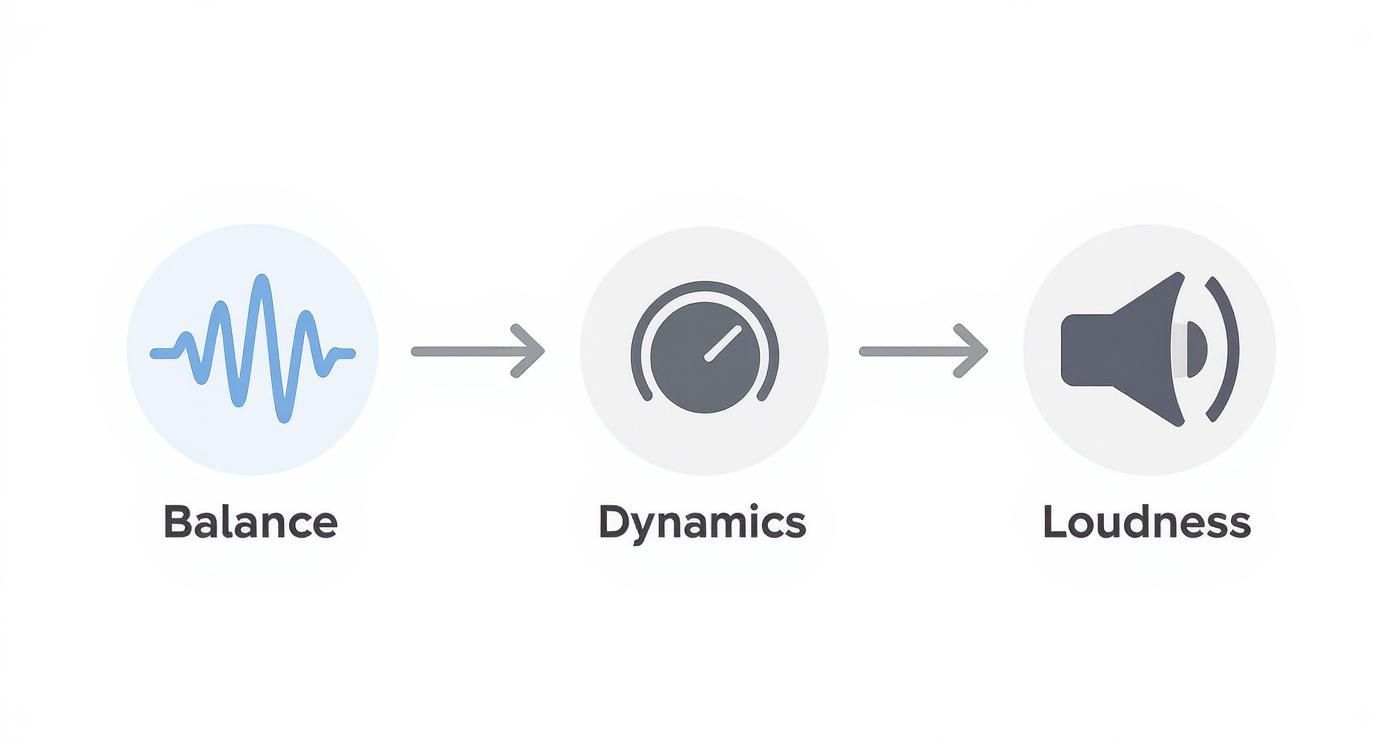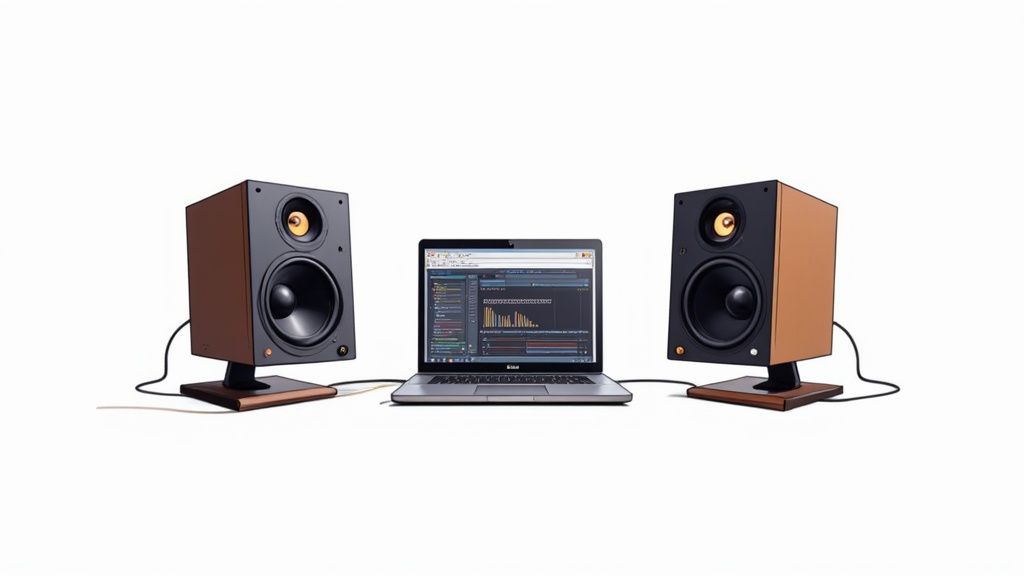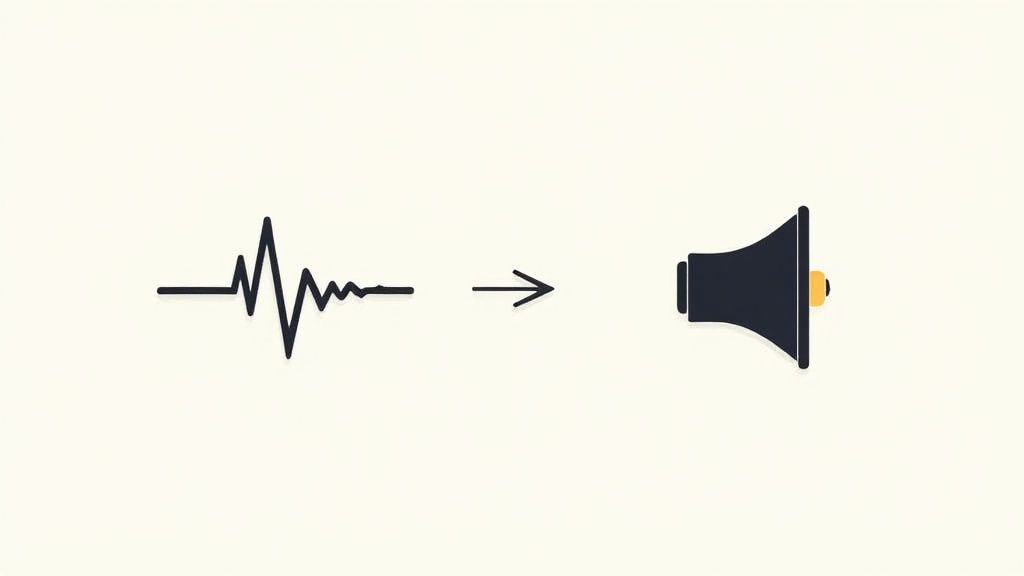A mastering engineer is the final quality control expert in the music production chain. Their job is to take a great mix and make it ready for the world.
Think of them like a photo editor for a magazine cover. The photo is already amazing, but the editor makes sure the colors pop consistently across every page and looks perfect under any light. A mastering engineer does exactly that, but for sound, applying the final touches that make a song loud, clear, and impactful on any device.
The road from a raw recording to a radio-ready hit has a few key stops, and mastering is the last, critical one. It’s the essential bridge connecting the creative chaos of the studio to the fan’s headphones.
A mastering engineer takes the final mixdown and prepares it for distribution, ensuring it translates perfectly everywhere. We're talking earbuds, car stereos, club PAs, and laptop speakers. Their job isn't to fundamentally change the song, but to enhance what’s already there with subtle adjustments that make a massive difference. You can dive deeper into the market for these services in this industry report.
So, what does this "final polish" actually involve? A mastering engineer brings a much-needed objective perspective. The artist and mixing engineer have often heard the track hundreds of times; they’re just too close to it. The mastering engineer comes in with fresh ears to spot problems and find opportunities for improvement that others might have missed.
Here’s a quick look at what’s on their checklist:
This table breaks down the key jobs a mastering engineer handles to get a track ready for release.
Ultimately, a mastering engineer's goal is to deliver a final product that is commercially competitive and emotionally resonant, no matter how or where people are listening. They are the last line of defense, guaranteeing the artist's vision is heard exactly as intended.
To really get what a mastering engineer does, you have to look at their workflow. This isn’t about just cranking up the volume; it's a careful, step-by-step process where every move builds on the last, all to get a track polished and ready for the world. It’s one part technical skill, one part artistic gut feeling.
The whole thing kicks off with the most important tool in the arsenal: a good pair of ears. In a room built for perfect acoustics, listening on brutally honest speakers, the engineer gives the track a deep, critical listen. They aren't just jamming out; they're diagnosing the mix. They’re hunting for any weird tonal balances, dynamic hiccups, or stereo image problems that could make the song fall flat on a car stereo or cheap earbuds.
This first listen basically creates the roadmap for everything else.
With a clear picture of what the track needs, the first tool that usually comes out is the equalizer, or EQ. Think of it like sculpting with sound. A mastering engineer uses incredibly precise EQs to carve out space and add shine, making tiny tweaks that bring the whole mix into focus.
This is usually a two-part job:
This visual gives you a good idea of the general flow, from balancing frequencies with EQ, to taming dynamics, and finally, pushing the loudness.

The goal here is to make sure every instrument has its own pocket to sit in, which ultimately makes the final master sound both clearer and way more powerful.
Once the track’s tone is dialed in, the attention shifts to the dynamic range—the gap between the quietest whispers and the loudest bangs. A mastering compressor is the tool for this job, used to gently "glue" the track together. It tames the wild peaks and brings up the quieter parts, creating a sound that feels more cohesive and hits harder.
A great way to think about it is like a conductor leading an orchestra. The conductor makes sure no single instrument overpowers the others, allowing the entire group to sound like one powerful, unified force. A mastering compressor does the exact same thing for a song.
After compression, the engineer looks at the stereo image—how wide or narrow the track feels. They might tuck the low-end frequencies into the center to create a solid, punchy foundation. Then, they’ll carefully widen out the mids and highs to make the track feel huge and immersive, all without causing weird phasing problems that can make a mix fall apart.
The final, and maybe most famous, step is optimizing for loudness. Using a special tool called a limiter, the engineer pushes the track's overall volume up to meet the competitive levels of today's music world, like the -14 LUFS standard you'll find on Spotify. The trick is to get it loud enough to grab attention without crushing all the life out of it or introducing nasty distortion. You can see how all these processors fit together in a typical audio mastering chain.
With the sound locked in, the last job is to export all the different files needed for distribution. This means creating high-resolution WAV files for streamers, MP3s for downloads, and even specially prepared masters for vinyl or CD if that’s in the plan. Each and every format gets a final quality check to make sure the artist’s vision sounds incredible, no matter where someone presses play.
A mastering engineer's studio is a far cry from your typical recording space. It’s less of a creative den and more of a surgical suite—a precision-tuned environment built for one thing: hearing the absolute, unvarnished truth of a recording. This commitment to brutal honesty is the bedrock of their craft.
It all starts with the room and the speakers. We’re talking about incredibly accurate studio monitors in an acoustically treated space, designed to reveal every tiny detail and flaw. The goal isn't speakers that sound "good" or "flattering"; it's speakers that are ruthlessly honest. Without this pristine listening setup, every decision that follows is just guesswork.
Below is a look at a typical digital audio workstation (DAW) during the mastering phase.

You can see the waveform of the entire track laid out, with a chain of plugins ready to polish the final sound.
So, once the listening environment is dialed in, what happens next? The engineer reaches for a specialized set of tools. Think of these processors as the final set of paintbrushes used to complete the sonic picture.
The age-old debate in mastering circles is analog hardware versus digital plugins. There's a real love for analog gear—with its tubes, transformers, and transistors—for the warmth, character, and musical mojo it brings to a track. For that final touch of class, many engineers swear by high-end hardware like the Rupert Neve Designs Portico II Master Buss Processor.
On the other hand, digital plugins offer surgical precision, unmatched convenience, and the ability to recall settings perfectly every time. The truth is, most modern engineers use a hybrid setup, grabbing the best of both worlds.
Using this combination of gear, engineers carefully manage loudness and dynamics to meet the standards of streaming platforms, like the common -14 LUFS target.
This is where AI-powered tools like CarMaster come into the picture. They make these advanced processing techniques accessible to everyone, packing sophisticated algorithms into an automated workflow. It’s a way for artists to get a polished, professional sound without needing a deep background in audio engineering.

Knowing what a mastering engineer does is one thing. But truly getting why their work is non-negotiable for any serious release? That's another story. Think of it as the final quality control checkpoint, the last line of defense ensuring your music hits listeners exactly how you heard it in your head.
Mastering really boils down to three key results: translation, competitive loudness, and cohesion. Skipping this stage is like shooting a gorgeous film but never bothering to color grade it. All the raw potential is there, but you're leaving the final impact completely up to chance. This is the step that guarantees your artistic vision survives the messy journey from your studio to the real world.
The number one job of mastering is to make sure your music translates. A track can sound absolutely massive on your studio monitors, but what about on laptop speakers? In a car? Through a pair of cheap gas station earbuds? The mastering engineer's mission is to make sure your mix sounds balanced, clear, and powerful across all of them.
Without this step, a track with a killer low end could easily turn into a muddy, distorted mess in a Honda Civic. A bright, airy mix might become painfully harsh on someone's headphones. Mastering is basically a universal translator for your audio. That's why services like CarMaster exist—they focus laser-tight on the most notoriously difficult listening environment, the car, tackling common gremlins like phase cancellation that can make a great mix completely fall apart on the road.
We live in the age of the playlist. Your song is going to be sandwiched right between tracks from the biggest artists on the planet. Mastering makes sure your music has a competitive volume, so listeners aren't instinctively reaching for the volume knob the second your track comes on.
This isn't just about cranking the volume to 11. It's about optimizing loudness without squashing the life out of your track. A pro master hits the commercial standard, like the -14 LUFS target for Spotify, while keeping all the punch, dynamics, and emotional impact you worked so hard to create in the mix.
If you're releasing an album or an EP, mastering is the glue that turns a collection of songs into a unified project. The engineer meticulously balances the tone, EQ, and volume of each track so the whole thing flows seamlessly from one song to the next.
This is what creates a truly professional listening experience from start to finish. The engineer ensures that your quiet acoustic ballad doesn't feel weak and thin after a high-energy rock track. They shape the overall sonic character so the project feels intentional. It’s that final polish that signals to the listener that they’re experiencing a complete, thoughtfully crafted work of art.
The rise of artificial intelligence has kicked off a huge debate in the audio world: can a machine really replace the seasoned ears of a mastering engineer? The answer isn't a simple yes or no. It’s more about understanding what each brings to the table and figuring out the right tool for the job.
There's no denying that automated mastering platforms are a game-changer, especially for indie artists. They spit out results almost instantly, which is a lifesaver for musicians on a tight deadline or an even tighter budget. This has opened doors for creators to get polished, competitive-sounding tracks without the traditional wait times or studio costs.
But a seasoned mastering engineer has something an algorithm will never possess: artistic intuition. We're talking about a gut feeling honed over thousands of hours of listening to every genre imaginable. This is what lets them tap into the emotion of a song and make choices that serve the artist's original vision.
A human engineer offers a level of collaboration and emotional intelligence that AI just can’t touch. They can take subjective feedback like "make it warmer" or "give it more punch" and translate that feeling into specific technical tweaks. That back-and-forth is often where a good master becomes a truly great one.
Think of it like this: AI can follow a recipe perfectly every single time, guaranteeing a consistent result. But a world-class chef understands the ingredients on a deeper level. They know when to add a pinch of something unexpected, adapting the recipe to create a dish that's truly special. The human engineer is that chef.
This kind of shift is happening everywhere, not just in music. For a wider view on how AI is changing creative fields, it's interesting to look into things like the future of marketing with AI.
To get a bit more specific, let's break down the core differences between these two approaches.
This table lays out the trade-offs pretty clearly. Neither is inherently "better"—they just serve different needs at different stages of an artist's journey.
Deciding between a human and an AI really just depends on your immediate needs.
If you're an artist working on your first demo, or you need a track mastered right now for a TikTok video, an AI service like CarMaster is a fantastic solution. It delivers a fast, affordable, and surprisingly solid result without breaking the bank. There are many types of mastering out there, and AI has definitely carved out a vital space for itself.
But if you're getting ready to release an album or a single that you've poured your soul into, the partnership with a human engineer might be the way to go. Their ability to give detailed feedback, understand your influences, and push the creative boundaries of your sound is something you just can't put a price on.
Ultimately, it’s not about which one wins. It’s about knowing your options and choosing the one that best fits your goals, your budget, and your timeline.
Even after you get the basic idea, mastering can still feel like a bit of a mystery. It's this critical final step, but it's often the most misunderstood part of making a record. Let's tackle some of the most common questions artists have.
Getting these answers straight is essential for planning your release, from budgeting to timelines. Think of this as your final briefing before sending your tracks off for that crucial last polish.
This is, without a doubt, the number one question. And the distinction is everything.
Simply put: mixing is about the parts, mastering is about the whole.
When you're mixing, you're working with all the individual tracks—the kick, the snare, the bassline, the vocals, the synths. The job is to balance them, make them sit together nicely, and create a single, cohesive stereo file. The focus is internal to the song.
Mastering only starts after that final mix is printed. A mastering engineer takes that single stereo file and gets it ready for the world. Their focus is external: making sure the song sounds incredible on a laptop, in a car, on AirPods, and that it holds its own against other commercial tracks on Spotify. They aren't tweaking the snare volume; they’re polishing the entire song as one piece.
A good analogy? If your song is a cake, mixing is combining the flour, sugar, and eggs and baking it perfectly. Mastering is adding the frosting and decorations to make it ready for the party.
Hiring a pro is an investment, for sure, and the price tag can swing pretty wildly. A few things determine what you'll pay:
The short answer is yes, you can. The better question is, should you?
With all the powerful plugins available in modern DAWs, DIY mastering feels more accessible than ever. But it’s loaded with pitfalls. The biggest one is objectivity. After pouring your soul into writing, recording, and mixing your track for weeks or months, you've lost all fresh perspective. You're just too close to it—we call it "mix blindness."
The other massive challenge is your listening environment. Professional mastering studios are acoustically treated, fine-tuned rooms with insanely accurate speakers. Most home setups just can't compete. Making critical mastering decisions on speakers that don't tell you the whole truth is like trying to paint in the dark.
While mastering your own music can be a great way to learn, for a public release, you owe it to your music to get a second, expert set of ears on it.
Ready to give your music that professional finish without the high costs or long turnaround times? CarMaster is built from the ground up to make your tracks sound incredible in the car and everywhere else. Get your free, instant preview and hear the difference for yourself at https://www.carmaster.io.